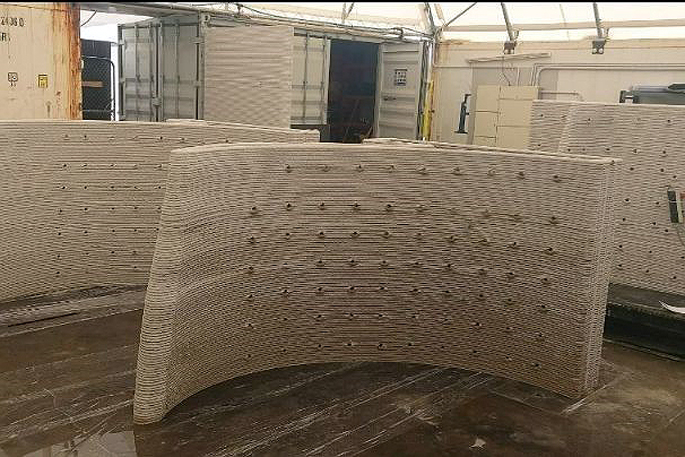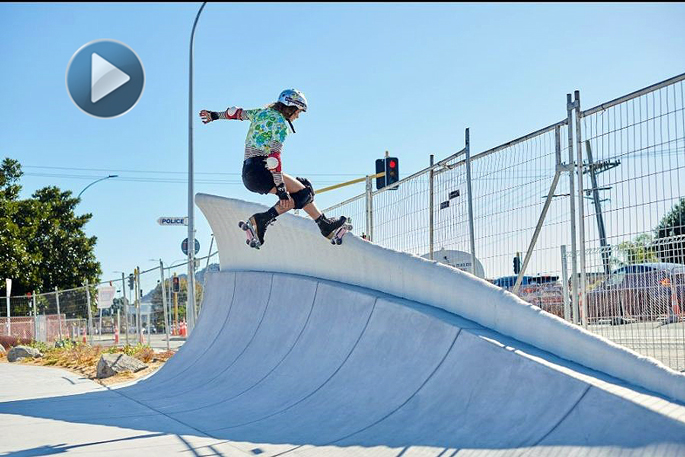A new skatepark in Mount Maunganui is utilising the use of 3D printing.
The new Destination Skatepark, which is expected to officially open this week, features the largest known 3D printed skate sculpture across the globe.
‘The Wave’ is one of five 3D printed skateable features and is almost 12 metres long and 3 metres high. Other 3D print features include a quarterpipe and skateable ledges.
Tauranga City Council, with specialist skatepark designer RICH Landscapes, were keen to explore some new and sustainable technologies when developing the Bay of Plenty’s newest and largest skate facility.
“There are only a small handful of skateparks we know of internationally (in France and England) using this technology, but on a much smaller scale,” says Peter Fraser, council’s design lead for Destination Skatepark.
“It’s a new and innovative way to make unique features. We’ve created new forms and textures that would have been too expensive to make by traditional production methods.”
The community-influenced co-design process involved a 24-member group representing multiple roller codes and modes (including skateboarding, BMX, scootering, inline and roller skating) working alongside RICH Landscapes and Council.
“Destination Skatepark has been designed with the community in mind. We’ve included
a number of skate zones which cater for all ages and abilities. Zones one and two focus on facilities for more experienced skaters, while zones three and four were specifically designed for developing basic and intermediate roller skills,” says Peter.
To build the 3D printed skateable sculptures, the Destination Skatepark project team teamed up with Hamilton-based QOROX, New Zealand’s only 3D print construction company and an early adopter of the technology.
The 3D printed skateable features are made up of ‘Q-Ink’ (QOROX 3D printing ink), which is locally mixed and made of a special low-carbon material which produces 30% less emissions than normal concrete, says director of QOROX, Wafaey Swelim.
“Q-Ink is 20 per cent lighter than normal concrete. It’s a rapid set, high strength material and a more environmentally friendly option, with the same robustness of traditional concrete. The process of 3D printing inherently leans itself to creative and organic designs without the need for expensive moulds that would make building these designs very complicated and cost-prohibitive.
The skatepark’s new 3D printed features include the 12-metre-long Wave, 3D printed skateable walls/quarterpipe, skateable art ledges and some standard skinny ledges.
The largest feature, the Wave, is comprised of seven segments and took around five hours to print.
 The Wave, one of several 3D printed skateable features at the new Destination Skatepark, is comprised of seven segments and took around five hours to print in total.
The Wave, one of several 3D printed skateable features at the new Destination Skatepark, is comprised of seven segments and took around five hours to print in total.
Specialist skatepark designer Richard Smith, director of RICH Landscapes, says with the 3D printing of the Wave feature, it helped create a subtle feel of curling water.
“While the Wave is aesthetic, anyone can carve that element. The other 3D printed features are mostly intermediate to advanced use, though learners can use the standard ledge as a drop. They’re a world-first in terms of the magnitude of the multiple inground walls and features and the inground Wave.”
Built by Angus McMillan Concrete (AMC), other standout features of the wider skatepark include a flow bowl, a surf/skate ditch, competition style stairs, and a street skate area.
As a seasoned skater and having designed more than 80 skateparks in NZ and abroad, Rich is passionate about evolutionary work using revolutionary, yet sustainable, technology.
“Both locals and visitors will be kept busy for many years to come, honing their skills and working through all the features and lines this environment holds. Thanks to everyone involved in this project, we’ve delivered something truly inspiring for Aotearoa.”
Development of the new Destination Skatepark came about following community engagement on the city’s previous Long-term Plan.
After hearing loud and clear from Tauranga’s growing roller community that existing skateparks were too small, outdated and limiting for users, Council committed to improving citywide skate facilities including Destination Skatepark at the Mount, Gordon Spratt Reserve skatepark in Papamoa and an upgrade of Memorial Park in Tauranga.
Destination Skatepark, located on the corner of Hull Road and Maunganui Road, opens to the public on Wednesday afternoon. Get ready to roll!
 Surfing the concrete waves: riders test some of the new 3D printed skateable features at the new Destination Skatepark, opening later this week.
Surfing the concrete waves: riders test some of the new 3D printed skateable features at the new Destination Skatepark, opening later this week.



0 comments
Leave a Comment
You must be logged in to make a comment.